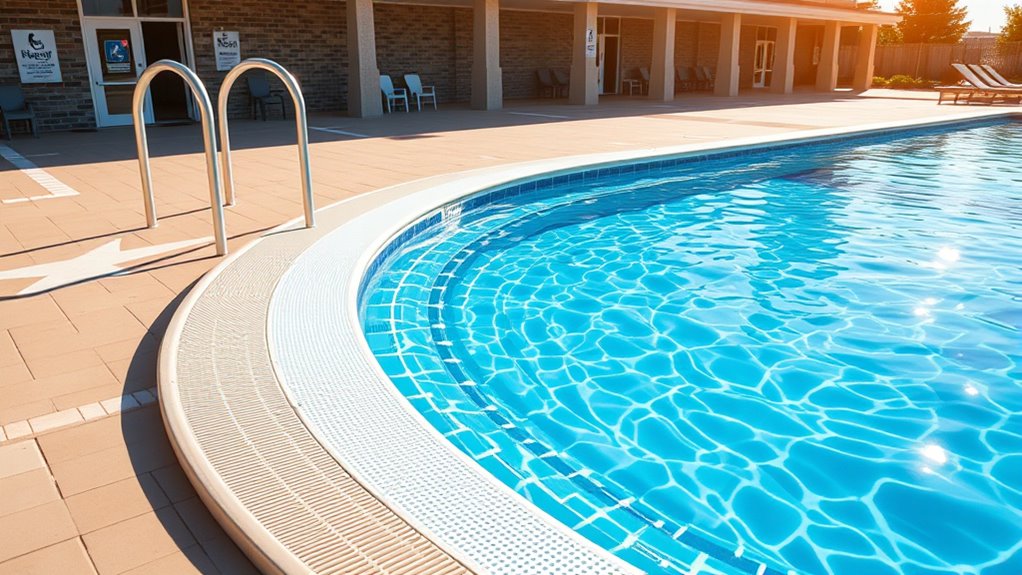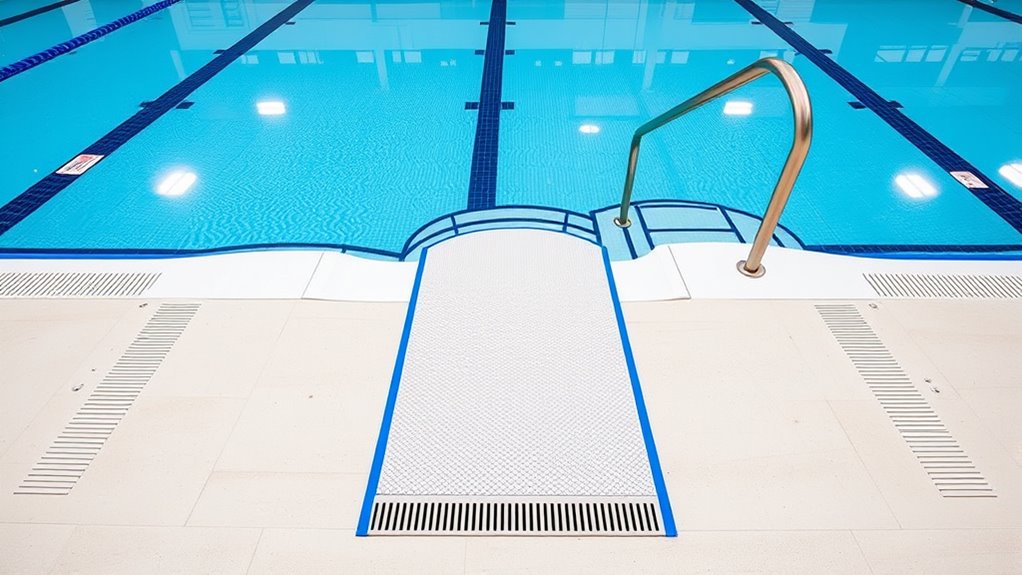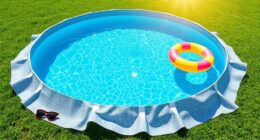When designing ADA-compliant commercial pools, you should incorporate clear, high-contrast signage to guide visitors and easy-to-operate pool lifts for safe access. Guarantee pathways are wide, obstacle-free, and the lift is positioned near the pool’s entry. Regular maintenance and proper anchoring are essential for safety. Focusing on inclusivity shows your commitment to all users. Keep these principles in mind—you’ll find process details that can help you create a welcoming, accessible space.
Key Takeaways
- Install accessible signage with high contrast, large lettering, and clear icons throughout the pool area.
- Incorporate sturdy, easy-to-operate pool lifts near entry points, securely anchored and regularly maintained.
- Ensure pathways are wide, obstacle-free, and designed for wheelchair and mobility aid access.
- Comply with ADA regulations by integrating accessible features that do not obstruct pathways or amenities.
- Design the pool environment to promote inclusivity, safety, and community engagement through thoughtful layout and features.

Creating an ADA-compliant commercial pool is essential to guarantee accessibility for all users. When designing your pool area, you need to consider features that assist individuals with disabilities in entering, navigating, and enjoying the space safely and comfortably. One of the most straightforward ways to promote accessibility is through the strategic placement of accessible signage. Clear, well-placed signs help guide visitors to key areas such as entry points, pool lifts, and accessible restrooms. Use large, high-contrast lettering and simple icons to ensure visibility for everyone, including those with visual impairments. Proper signage reduces confusion and helps users locate accessible features quickly, creating an inclusive environment that welcomes all guests.
Strategically placed, high-contrast signage ensures accessibility and inclusivity for all pool visitors.
In addition to signage, installing a reliable pool lift is critical for meeting ADA standards. Pool lift installation provides a safe, independent way for individuals with mobility challenges to access the water. When selecting a pool lift, choose models that are sturdy, weather-resistant, and easy to operate. Ensure the lift is positioned at a compliant location near the pool’s entry point, allowing users to transfer smoothly into the water. Proper installation involves secure anchoring and regular maintenance checks to guarantee safety and functionality over time. By integrating a quality pool lift, you not only adhere to legal requirements but also demonstrate your commitment to inclusivity, making your pool accessible to a broader audience.
Designing for accessibility begins with understanding the needs of all potential users. Incorporate accessible signage throughout the pool area, including directions, warnings, and information about pool rules. This not only helps guests with disabilities but also enhances overall safety for everyone. When installing a pool lift, consider the pool’s size and shape to determine the most effective location, ensuring that it doesn’t obstruct pathways or other amenities. Keep pathways wide and free of obstacles to facilitate easy movement for wheelchair users and those with mobility aids. These adjustments create a seamless experience for all visitors, emphasizing that your pool is designed with inclusivity in mind. Additionally, integrating holistic approaches to health and wellness can further elevate the accessibility and comfort of your pool environment.
Ultimately, achieving ADA compliance involves thoughtful planning and the integration of accessible features like signage and pool lifts. These elements serve as the foundation for a welcoming environment, where all guests can enjoy the water safely and comfortably. By prioritizing accessibility in your design, you not only meet legal standards but also foster a sense of community and respect. Your commitment to inclusivity will be evident in every aspect of your pool’s layout, making it a true destination for everyone seeking leisure and recreation.
Frequently Asked Questions
What Are the Latest ADA Regulations Affecting Pool Design?
You need to guarantee your pool design meets the latest ADA regulations by including accessible signage that clearly indicates accessible features. Additionally, pool lift requirements specify that you must provide at least one accessible lift or sloped entry, ensuring users with disabilities can safely access the water. Stay updated on these rules to create an inclusive, compliant environment that accommodates all visitors, promoting safety and accessibility effectively.
How Can I Retrofit Existing Pools to Meet ADA Standards?
To retrofit your existing pools for ADA compliance, start by installing a pool lift to provide accessible entry. Add clear accessibility signage around the pool area to guide users. You might also consider widening pathways and ensuring non-slip surfaces for better safety. These modifications make your pool more inclusive, allowing everyone to enjoy it comfortably and safely while meeting ADA standards.
What Are the Costs Associated With ADA Compliance for Pools?
The costs of ADA compliance for pools can feel like an astronomical figure, but they’re essential for ensuring pool accessibility. You should expect to invest anywhere from a few thousand to tens of thousands of dollars, depending on the pool’s size and existing infrastructure. A precise cost estimation considers modifications like ramps, lifts, and accessible routes, making sure your pool meets ADA standards and is welcoming to everyone.
Are Portable or Temporary Pools Subject to ADA Requirements?
Temporary installations and rental pools are generally not subject to ADA requirements unless they are intended for permanent use or public access. If you plan to host these pools long-term or make them accessible to all users, you should consider ADA compliance to avoid legal issues. Always check local regulations, as rules may vary. Ensuring accessibility can also improve customer satisfaction and demonstrate your commitment to inclusivity.
How Do ADA Standards Vary by State or Local Regulations?
You should know that ADA standards can vary by state and local regulations. State variations may add specific requirements beyond federal guidelines, and local enforcement can differ in strictness or interpretation. It’s essential to check with your state or local authorities to guarantee your commercial pool design complies with all applicable ADA standards. Staying informed helps you avoid legal issues and creates an inclusive environment for all users.
Conclusion
Designing ADA-compliant commercial pools isn’t just about meeting regulations; it’s about opening a world of inclusivity and accessibility. By embracing these standards, you create a space where everyone can enjoy the water’s embrace, breaking down barriers like a lighthouse guiding ships safely home. Remember, your pool is more than a feature—it’s a symbol of community and care. When you prioritize accessibility, you transform a simple pool into a sanctuary where all are welcome to leap in.




